
The 12 Best And Worst Sugar Substitutes

Posted on 13 Mar, 2021

Sugar is the most used sweetener in food preparation, mostly derived from sugarcane and sugar beets. Called sucrose but also referred to as table sugar, it is a refined carbohydrate that, when broken down in the body, becomes half glucose and half fructose.
Various types of sweeteners are often substituted for sugar, which contains 40 calories per tablespoon, usually in hopes of lowering the calorie count, controlling blood sugar or generally improving health.
Sugar substitutes, a controversial topic, fall into one of two categories: natural sweeteners (which include sugar alcohols like erythritol) and nonnutritive sweeteners like sucralose (aka Splenda).
We took a deep look into the 12 sugar substitutes that are most likely to show up in your pantry and loosely ordered them from best to worst. However, talk to your doctor or registered dietitian nutritionist to find a sweetener that best suits your health situation.
We didn't include other forms of sugarcane and sugar beet extracts like brown sugar, specialty sugars like Turbinado and Demerara, or liquid sugars like molasses, even though some of those, like blackstrap molasses, offer more vitamins and minerals than most other sugarcane-derived products.
The Best Six
 Dates
Dates
Dates are berries from palm trees that come in two types: soft dates and semi-dry. Using fruit as a sugar substitute is a good strategy for reducing added sugars because they are natural sugars that are accompanied by high dietary fiber, phenolic compounds, vitamins and minerals.
Dates, especially fresh rather than dried, have also been found to contain high levels of antioxidants and have antimutagenic properties, meaning they can potentially minimize the risk of cancer and cardiovascular disease, according to the Emirates Journal of Food and Agriculture.
With a glycemic index of 42, the fruit can be used to sweeten baked goods and smoothies — but note that a little can go a long way in terms of sweetness, especially when using dried dates. Also, different kinds of dates are different sizes and therefore the per date calorie count will be higher the larger and, in some cases, denser the date. For instance, Medjool dates are often larger than the more common Deglet Noor date and therefore have more calories.
 Maple Syrup
Maple Syrup
Maple syrup comes from boiling the sap from maple trees. The color of the syrup is a result of when the sap was tapped in the season; early season maple sap produces lighter syrup and later in the season, darker syrup.
The government specifies that maple syrup must contain at least 65.5 percent sugar among its other ingredients, like the acids and salts, to be authentically considered maple syrup, but many maple syrup products in stores today are blended with corn syrup and/or cane sugar syrup because maple syrup itself is expensive. Its glycemic index is 54, and it contains higher levels of minerals and fewer calories than honey.
Calories: 52 per tbsp
 Honey
Honey
Derived from the nectar bees create in their honeycombs, it takes an extraordinary amount of bees to create enough honey for humans to use. The sugars in honey are 40 percent fructose , 35 percent glucose and two percent sucrose. While honey can be used in baking, it should not replace sugar 1:1, and the liquid in the recipe must be adjusted due to the water content in honey. Honey also has a more pronounced flavor than sugar.
Although popular culture seems to believe honey is better than sugar, it is a pretty close comparison due to its composition, according a Huffington Post article. Indeed, its GI is 61, while table sugar is at 58, but it may offer some extra minerals, such as zinc and selenium.
Calories: 64 per tbsp
 Coconut Palm Sugar
Coconut Palm Sugar
Coconut palm sugar comes from sap from a coconut tree. It has a similar taste and texture as brown sugar. Many believe it is a better sweetening option due to its low glycemic index. However, according to the American Diabetes Association, it should not be treated differently than sugar as it has a similar profile, offering about the equivalent in calories and carbohydrates.
The glycemic index for coconut palm sugar is 35 because it is mainly sucrose with small amounts of fructose and glucose as well as inulin (a fiber that acts as a prebiotic), nutrients and antioxidants.
Calories: 45 per tbsp
 Agave Nectar
Agave Nectar
Agave nectar comes from the succulent plant agave, which comes from Mexico. The juice is extracted, filtered, heated and then hydrolyzed into syrup, a process similar to how high-fructose corn syrup is manufactured. Agave nectar is 90 percent fructose, while high-fructose corn syrup is 55 percent fructose.
Agave nectar is often used as a substitute for honey for vegans; however, it is much sweeter than honey, though, like coconut palm sugar, its GI is lower, at 15. Since it tastes very sweet, less is generally used, which is why some claim it is healthier. Yet because it still contains a high level of fructose, the level of healthiness in the long term is debatable.
Calories: 60 per tbsp
 Stevia (Pure Via)
Stevia (Pure Via)
Stevia comes from the leaves of a South American plant called Stevia rebaudiana, which is 200 to 300 times sweeter than sucrose, but can be bitter with an astringent or metallic aftertaste. It is a newer sweetener in the United States, but it has been used in other countries, such as Venezuela, Brazil and Colombia, for more than a thousand years.
Stevia had been banned in the United States until 1995 when the FDA approved it as a dietary supplement. There's been some evidence that stevia can be mutagenic in bacteria and rats, but it has been recognized as safe due to the length of time humans have been using it.
An article in the journal Industrial Crops and Products states that studies on the toxicology of stevia have demonstrated that stevia poses no risks in humans when consumed as a sweetener. Stevia may even help to lower blood pressure in those that have hypertension. The glycemic index of stevia is 0.
Calories: 0
The Not So Good Six
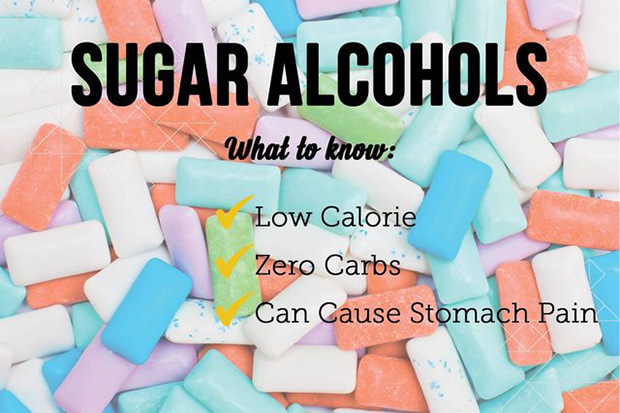 Sugar Alcohols
Sugar Alcohols
Foods that are made with sugar alcohols (such as xylitol, sorbitol and erythritol) instead of sugar can be labeled as “sugar free” because of how low the calorie count is for sugar alcohols.
Sugar alcohols are not carbohydrates like sugar is. Sugar alcohol can be found naturally in produce, but most packaged varieties have been created in the lab. These alcohols are 20 percent to 100 percent as sweet as sucrose but are not digested by intestinal enzymes, which is why they have fewer calories. They're used in diet foods because of their ability to be slowly absorbed and because they do not contribute many additional calories.
Some sugar alcohols contribute a cooling sensation to the mouth, which is why they are used in items such as gums and mints. Another perk of sugar alcohols is that they do not contribute to dental caries (cavities) because bacteria cannot digest them.
One of the problems that arise from sugar alcohols comes from one of their pros, the slow digestion, which means that they move more slowly through the intestine, possibly causing abdominal issues like diarrhea, abdominal pain and gas. The glycemic index for sugar alcohols is much lower than others (for example, xylitol’s is 7).
Calories in xylitol: 30 per tbsp; calories in erythritol: 2.4 per tbsp; calories in sorbitol: 36 per tbsp
 Brown Rice Syrup
Brown Rice Syrup
Brown rice syrup is a viscous liquid that is derived from brown rice treated with enzymes to break down the starches, and, while not nearly as sweet as white sugar, it has a slight butterscotch flavor, lending well to some types of baking.
Due to it containing about 50 percent complex carbohydrates and 3 percent glucose, rather than only simple carbohydrates, its sugars are released more slowly into the bloodstream, creating a less visible spike in blood glucose.
However, according the "The Essential Good Food Guide" by Margaret Wittenberg, the level of glucose can be adjusted during the manufacturing process, so the glycemic index of the syrup can be dependent on the individual product. Also of note, there have been recent concerns about the levels of arsenic in brown rice because the plant absorbs arsenic from the environment as many plants do, and the hull, which is present in brown rice but not white rice, retains the absorbed arsenic, according to the Mineralogical Society of America.
The FDA has increased its arsenic testing of rice products since 2011 but has yet to release a comprehensive risk assessment, but Consumer Reports recommends limiting consumption, especially for children under 12 months.
Calories: 75 per tbsp (in the Lundberg brand)
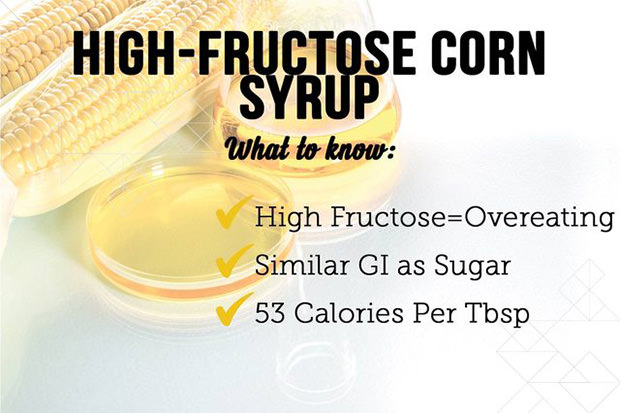 High-Fructose Corn Syrup
High-Fructose Corn Syrup
Corn syrups are a byproduct of cornstarch production are often used in products to reduce the manufacturing cost. While corn syrup is essentially 100 percent glucose, high-fructose corn syrup can be anywhere from about 40 to 90 percent fructose, and because it is a synthetically made sweetener, a monosaccharide, the levels of fructose can be very high, rather than a combination of both fructose and glucose like sucrose.
It has a high sweetening power, it is not as sweet as sugar or agave nectar, so more of it may be used in packaged foods. Fructose moves quicker in the digestive system than glucose, so it may be harder to feel satiation, increasing consumption. The glycemic index of high-fructose corn syrup is similar to that of sucrose.
Calories: 53 per tbsp
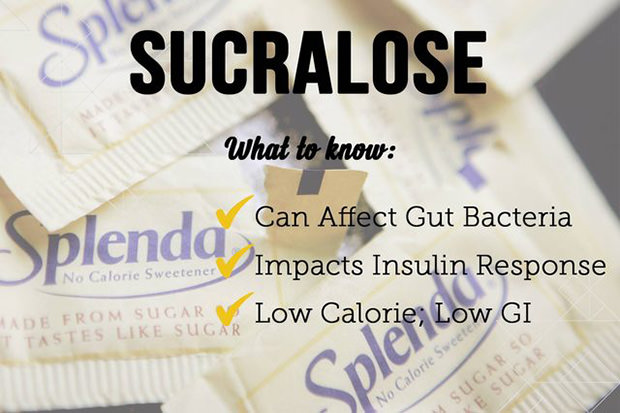 Sucralose (Splenda)
Sucralose (Splenda)
Sucralose is a nonnutritive sweetener that is able to withstand high temperatures, making it appropriate for baking. It is used in countless manufactured products, perhaps because it has a taste similar to sugar and does not have an unpleasant aftertaste like many other nonnutritive sweeteners seem to have. Sucralose is 600 times sweeter than table sugar.
There are controversial opinions about its affects on health even though it is considered safe for even pregnant and nursing mothers. According to a 2013 study in the Journal of Toxicology and Environmental Health found, it does in fact get metabolized once ingested and can negatively affect gut bacteria, impact the body's insulin responses and its broken down components can be gene altering.
Despite the controversies, it is not recognized in the body as a carbohydrate and therefore has been deemed as appropriate for patients with diabetes. The glycemic index of sucralose is 0.
Calories: Less than 5 per packet of Splenda (1 gram)
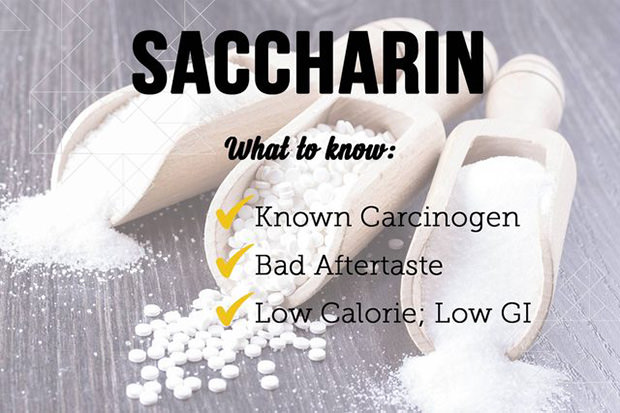 Saccharin (Sweet Twin, Sweet’N Low)
Saccharin (Sweet Twin, Sweet’N Low)
One of five nonnutritive sweeteners approved by the FDA for use in the US, saccharin was discovered accidentally when a scientist had some residue left on his hands from the lab when he made dinner rolls that turned out extra sweet.
Saccharin is 500 times sweeter than sucrose. It is used now in many baked and processed foods, although one of the drawbacks of saccharin for some is its aftertaste. There also has been controversy about the safety after some research on rats, including an FDA-proposed ban in 1977.
Instead, there is a warning label requirement on items containing saccharin now. It may cause cancer, but it appears to be one of the weaker known carcinogens. It would take 800 twelve-ounce sodas sweetened with saccharin to reach a concerning level for carcinogenesis. There is not enough evidence to cause alarm about consuming saccharin to date. The glycemic index of saccharin is 0.
Calories: Less than 4 per packet of Sweet'N Low (1 gram)
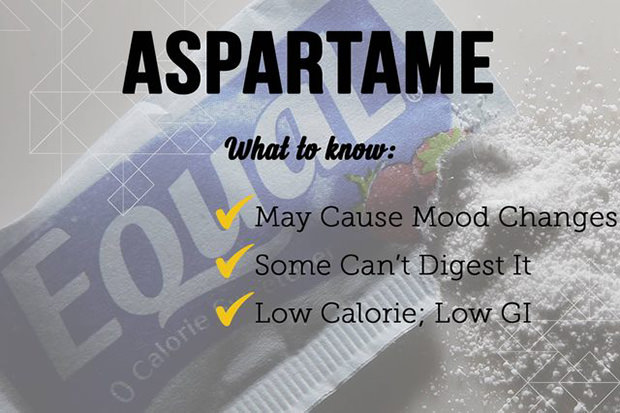 Aspartame (Equal, NutraSweet, Sugar Twin)
Aspartame (Equal, NutraSweet, Sugar Twin)
Another one of the FDA-approved nonnutritive sweeteners, it is one of the most controversial artificial sweeteners and yet the most popular.
Aspartame is mostly found in soft drinks and is 180 times sweeter than sucrose. It does not elicit the same insulin response as regular sugar does in the pancreas. While there is controversy about the safety of nonnutritive sweeteners in the human diet, it seems that a portion of the population that consumes aspartame has a difficult time digesting the breakdown products of this sweetener, reporting headaches, dizziness, mood changes and nausea. Aspartame has also been linked to some cancers in some rat studies.
A study in the journal Research in Nursing & Health found that participants on a high-aspartame diet compared to those on a low-aspartame diet scored lower on spatial orientation tests and were more irritable and depressed; therefore, there may be some neurobehavioral effects of the consumption of aspartame, as other studies have demonstrated. Regardless of the controversy about some side effects and the potential as a carcinogen, individuals with phenylketonuria should not consume aspartame. The glycemic index of aspartame is 0.
Calories: 4 per gram
Note: 15 grams are equal to one tablespoon
What Do YOU Think?
Does this change your ideas of what sugar substitutes are the best and worst? Which is your preferred choice and why? Tell us in the comments below!
Our Favorite Books On Eating Healthy

by Michael Moss

by John Berardi


by Jonny Bowden
 How To Pick The Best Milk For Yourself
How To Pick The Best Milk For Yourself How To Stretch Your Carbohydrate Intake
How To Stretch Your Carbohydrate Intake The 9 Safest Seafood Options
The 9 Safest Seafood Options The 10 Best Foods To Beat Your Sugar Cravings
The 10 Best Foods To Beat Your Sugar Cravings










